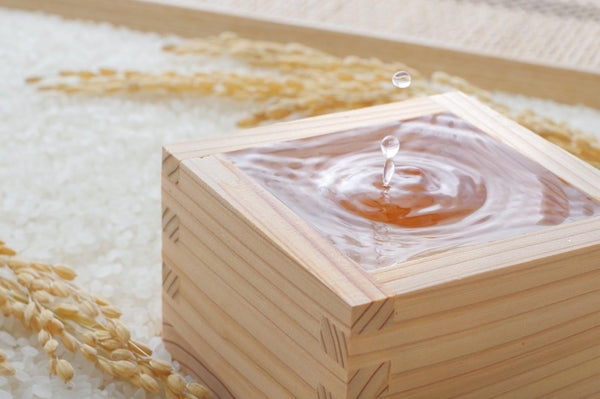
Jump to:
Japanese rice wine and rice vinegar are both made from rice, but they’re quite a bit different from one another (with a few similarities, too). But what makes them different? This article will explain that and more — what rice wine and rice vinegar are, how they taste, what they’re used for, and some good products to try.
Note: This article will focus on rice vinegar and rice cooking wine (cooking sake), not the sake you drink.
What Is Rice Wine?

Rice wine (sake) is something Japanese people most famously drink — like at a bar, for example. But it’s also used for cooking (much like cooking wine in the West). Japanese rice cooking wine (what this article will talk about) is called ryourishu. As you may know, ryouri means cooking, and shu means alcohol, liquor or sake. Sake for drinking has a special name, too — seishu (although it can be used for some cooking, too).
Ryourishu is usually made with a higher salt content than normal sake. This is to make it “undrinkable,” because there are laws that don’t allow drinkable rice wine to be sold as cooking sake. “The Japanese Liquor Tax Act requires cooking sake to have salt added to prevent its consumption as sake, and since cooking sake is not subject to the liquor tax it is also less expensive,” said Kikkoman (one maker of ryourishu).
What Is Rice Wine Made From?
Perhaps obviously, rice wine is made from rice. Wow! But specifically, it’s usually made from fermented rice (usually glutinous rice — mochigome — but some breweries use different rices).
The Spruce Eats says that during the fermentation process the “. . . sugars are transformed into alcohol thanks to the presence of yeast . . .” If you want to see how it’s made for yourself, check out this YouTube video showing the whole process.
Are There Different Kinds of Rice Wine?
There are many different types of rice wine in Japan. According to the famous soy sauce company, Kikkoman, rice wine “is available as a pure rice sake, but there are also products that contain added corn syrup or table salt.”
There is also a product called mirin (which has more than one variety, as well). It’s a bit sweeter, darker and thicker than cooking sake. Check out our article on the differences between sake and mirin and our article on mirin vs rice vinegar for more info.
Of all the different cooking sake you could try, you might want to give Fukumitsuya Organic Cooking Sake a go. It’s certified organic and made from pure rice. Its maker, Fukumitsuya, also makes hon mirin, other sake products and even food. The company is located in Kanazawa City in Ishikawa Prefecture and has been making sake for over 60 years (it’s the oldest sake brewery in Kanazawa)!
What Is Rice Vinegar?

Rice vinegar (komezu) is a common cooking ingredient in Japan. It has that sour, tart taste of other vinegars you may have tasted, but not quite as strong as in the West. It also has a slight sweetness to it. Next time you eat sushi, notice the rice doesn’t actually taste like plain rice — there’s a little vinegar in it!
Note: Rice vinegar is also called “rice wine vinegar,” but they are exactly the same thing — just a slightly different name.
What Is Rice Vinegar Made From?
Rice vinegar is actually made from sake (no wonder this gets confused with rice wine). How is it made from sake, you ask? Well, according to our own article on rice vinegar, “After filtering the finished sake, it is mixed with ‘pure rice vinegar’, and heated, and acetic acid bacteria are added. This process, called ‘acetic acid fermentation’, converts the alcohol component of the sake to acetic acid, which is the main component in rice vinegar.”
Are There Different Kinds Of Rice Vinegar?
There are so many different kinds of rice vinegars — there’s white rice vinegar, black rice vinegar and even artisanally crafted vinegars! If you’re looking for some good options, take a look at our top 13 Japanese vinegar picks.
In the crafted vinegar category, you might try Marusan Pure Rice Vinegar by Imagawa. This vinegar is matured slowly in a storehouse and isn’t as harsh as many other rice vinegar products. Its maker, Imagawa, is well-known for its high-quality, traditional standards, as well.
Another really interesting (and a bit unusual) Japanese vinegar option is the Marushige Migaki strawberry drinking vinegar. Yes, you can really drink it! Just add it to your favorite beverage — including cocktails. Its maker, Marushige, is a brewery in Fukuyama town in Kagoshima Prefecture. They are a bit different from other breweries because they use brown rice (genmai) and the same brewing methods they used in the Edo period (1603-1867).
One last suggestion — there is a vinegar brewing company called Tajima Jozo that makes some rather interesting and high-quality Japanese vinegars in Hyogo Prefecture. Perhaps the most interesting is their Akazu Red Vinegar. It’s made using a by-product of the sake production process (called sake lees) which gives it its red color, and it’s often used for making sushi.
What Are The Main Differences Between Rice Vinegar And Rice Wine?

Is rice wine the same as rice vinegar? It’s easy to get them confused, but as you can see, they aren’t actually the same. They do have some similarities, though. Both are rice-based products, and rice vinegar is made from sake. Other than that, however, they’re pretty different.
As far as flavor goes, vinegar is more bitter than sake (rice wine) and has a touch of sweetness. Rice wine, on the other hand, also has a bit of sweetness, but has that umami and alcohol taste.
Of course, these are general comparisons — there are many exceptions to the rule because there are so many different kinds of rice wine and vinegar. Try different ones out and find out for yourself!
How Did Rice Wine Become Popular In Japanese Cooking?
According to Hakusen Sake Brewery (in Japanese), sake was originally used as a dipping sauce (similar to how soy sauce is used today with sushi and sashimi). “As the range of cuisine expanded in the Edo period [1603-1867], it came to be used in simmered dishes and fried sake (an old Japanese seasoning made by adding umeboshi to sake and boiling it down), and became a secret ingredient in Japanese cuisine.”
How Did Rice Vinegar Become Popular In Japanese Cooking?
According to rice vinegar maker Nippon Natural Hakko (in Japanese), vinegar came over from China around the 4th or 5th century around the same time sake brewing was learned. “It wasn't until the Edo period [1603-1867] that vinegar became popular as a seasoning. The method of making vinegar spread throughout the country, and along with it many dishes using vinegar were created.”
Sushi was created around the Edo period, as well, and used vinegar in the rice. It was a hit and (as we all know) remains very popular today. But vinegar is used in lots of other foods (and drinks), too — often for sauces, marinades and other cooked dishes.
When Do We Use Rice Wine & Rice Vinegar In Cooking?

Rice wine and rice vinegar are both used in many dishes. How you use each one depends on your taste and what recipe you’re using.
Rice wine will add the flavor of alcohol, umami and a little sweetness to whatever food you’re preparing. For example, sukiyaki (something like a Japanese hot pot) has mirin (one type of rice wine) in it. This is what gives it that sweet and somewhat alcoholic flavor. Try our sukiyaki recipe! It’s delicious.
Rice vinegar, on the other hand, will add a slightly tangy flavor to whatever you’re preparing. Japanese people use it in sushi rice, dressing, pickles and more. If you’re a fan of natto (fermented soy beans), you might want to try vinegared natto. The recipe is in this Japanese YouTube video (with English subtitles), and there are a few other recipes involving vinegar in the video, too.
How To Store Rice Wine And Rice Vinegar?
For both rice wine (cooking sake) and rice vinegar, you can keep them somewhere cool and dark (like a pantry) before you open them. After opening, Kikkoman recommends storing them in the refrigerator. But honestly, plenty of people just leave them out on the counter, too. If you google it, you’ll see all the varying opinions on the subject.
Rice Wine & Rice Vinegar Substitutions

If you run out of (or just can’t get your hands on) rice wine or rice vinegar, what can you use as a substitute? Well, nothing will totally replace these ingredients, but you can get close. Here are a few that The Kitchen Community and Evolving Table suggest:
Rice Wine Substitutes
- any other rice wine (sake, mirin, etc)
- dry white wines
- dry sherry
- pale dry sherry
- fruit juices (grape, apple, etc)
Rice Vinegar Substitutes
- apple cider vinegar
- champagne vinegar
- sherry vinegar
- lemon or lime juice
- white vinegar
- chicken broth
Note: If you’re looking for a substitute for mirin (specifically) some suggest mixing sake (rice wine) with sugar. It’s not going to be perfect, but it works in a pinch!


0 comments